Nest Macarons
Hello friends! Today we will make Nest Macarons, they are perfect for Easter! These Nest Macarons are filled with Cadbury Egg Buttercream and topped with a buttercream nest and mini Cadbury Eggs.
Make sure to watch the video on this page or on YouTube, showing you exactly how to make these fun Easter macarons.
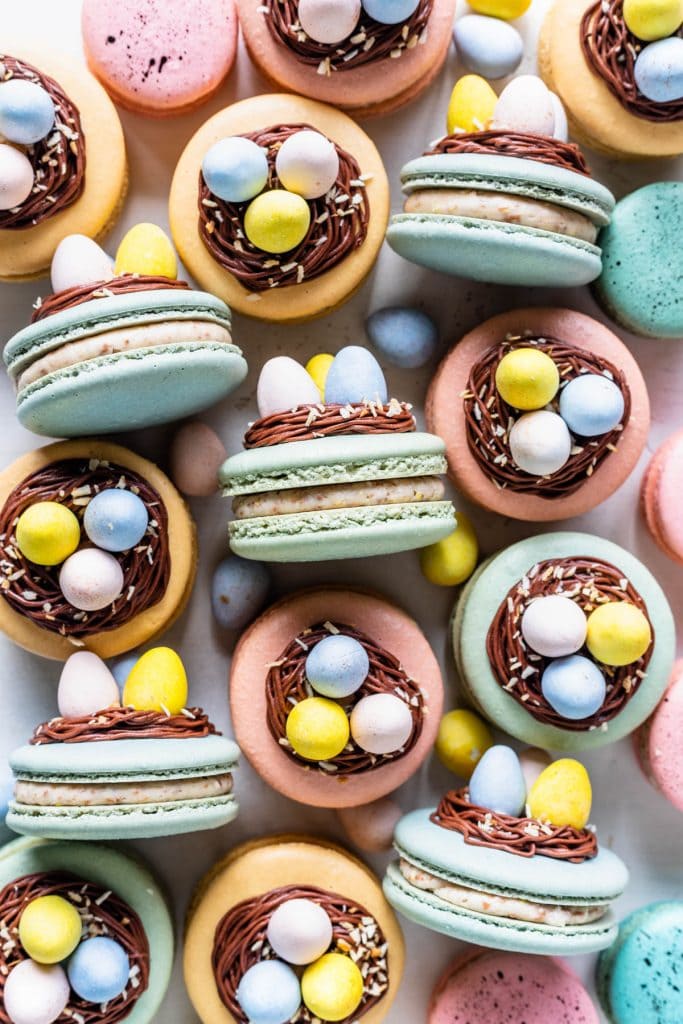
Carton Egg Whites
For these Nest Macarons I did another experiment using carton egg whites.
This post may contain affiliate links. I earn a commission from qualified purchases. Please read our Privacy policy here.
Last week I made these Spring macarons with 100% carton egg whites.
So this week I decided to continue my experiments and do something a little different.
I took the opportunity that I was making a ton of Easter Macarons, and made these Nest Macarons using 50% carton egg whites and 50% fresh egg whites.
And I also added 1 gram of egg white powder.
If the weather was more humid, I would have added 4 grams of egg white powder, however, since the weather is super dry where I am, I have been toning down on the egg white powder, because it makes the shells way too dry in the already dry weather.
Anyway, the egg white powder is completely optional, and if you decide to use it, you can play around with the amounts.
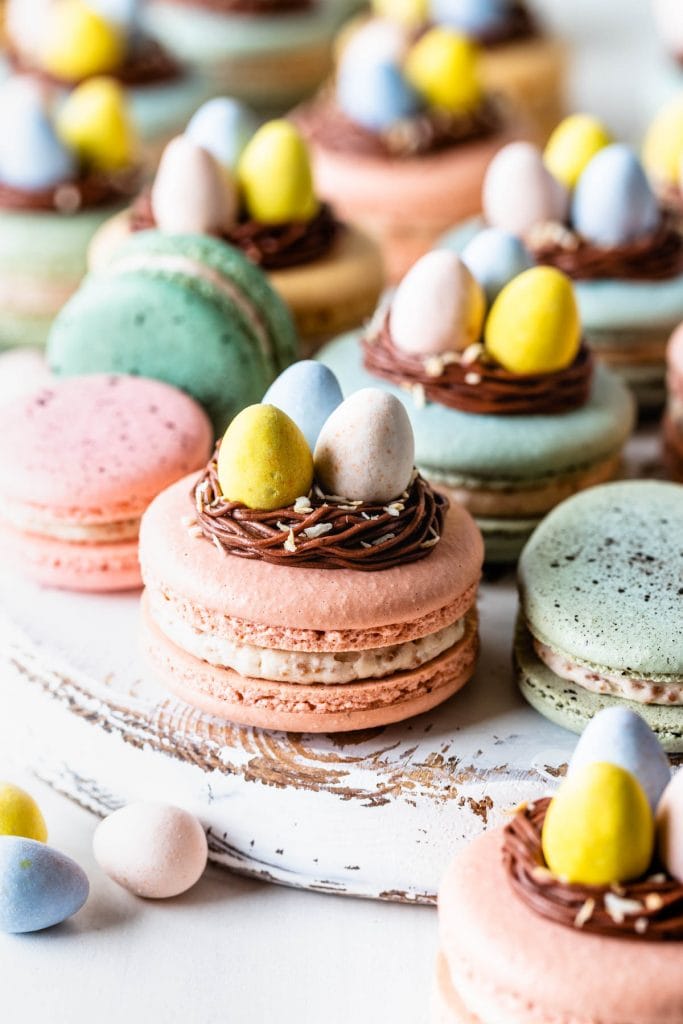
Why add Egg White Powder to the meringue?
Lately I haven’t been adding egg white powder to my macarons for the reason mentioned above: the weather has been super dry.
Egg white powder is nothing but dehydrated egg whites. Adding it to the meringue is the same as adding an extra layer of protein to its structure, which will provide you with a stronger meringue, and also a meringue with a lower water content.
For that reason, when the weather is too dry, the egg white powder can make the batter itself super dry. Over winter, I would make my macarons with egg white powder, and the minute I piped the shells, they would dry, not giving me enough time to even poke the air bubbles without forming streaks and bumps on the surface of the shell.
So I stopped adding egg white powder to my macarons over winter.
However, when it comes to using carton egg whites to make the meringue, you will end up with a meringue that is naturally softer. The egg white powder can be a great addition to carton egg white meringue, even if the weather is dry.
This is the egg white powder I use and recommend:
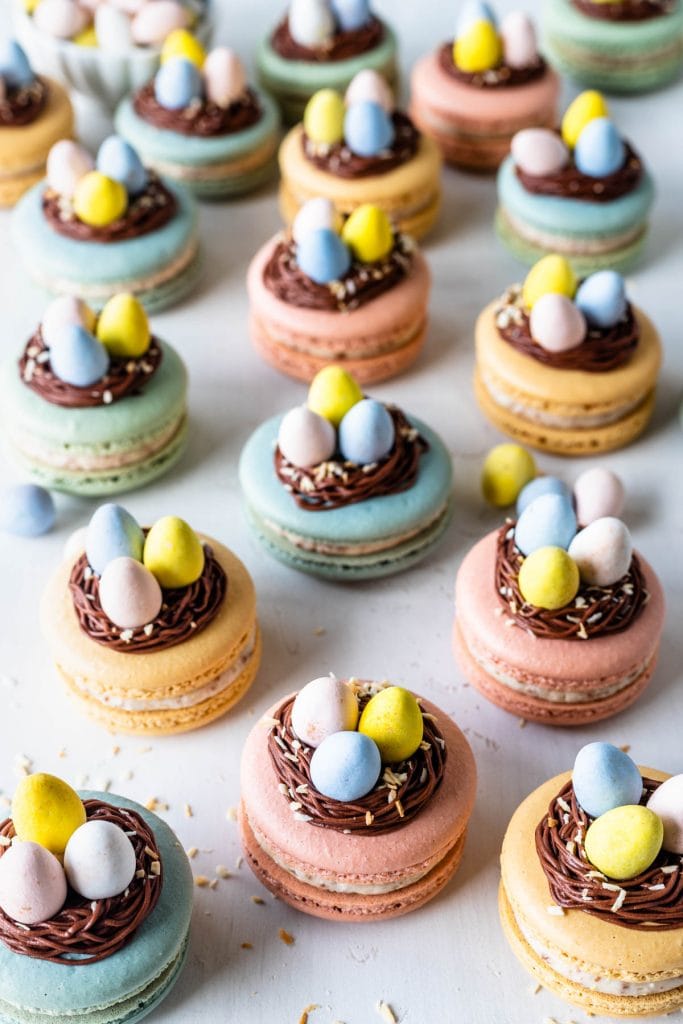
When I first made the Spring Macarons with 100% carton egg whites, the meringue took forever to whip. Now this time around, with the addition of some fresh whites and also the egg white powder, the meringue whipped much faster.
In general the shells of these Nest Macarons were sturdier, but also full and chewy in the middle! Just watch the video to see that texture!
So here is the big question:
Why use carton egg whites?
Carton egg whites are great for helping reduce waste of yolks. This is my main reason for trying them.
They are also convenient and save time that you would have to separate the eggs, etc.

I really recommend you give carton egg whites a chance specially if you do feel guilty throwing all those yolks out, or if you are running out of ideas on what to do with the yolks.
And you can play around with the ratios, and add more or less fresh egg whites to the carton whites when making the meringue. Or even use 100% carton whites as I have done here.
You could also add a pinch of cream of tartar (1/4 tsp per 100 grams of whites) to try and stabilize the meringue.
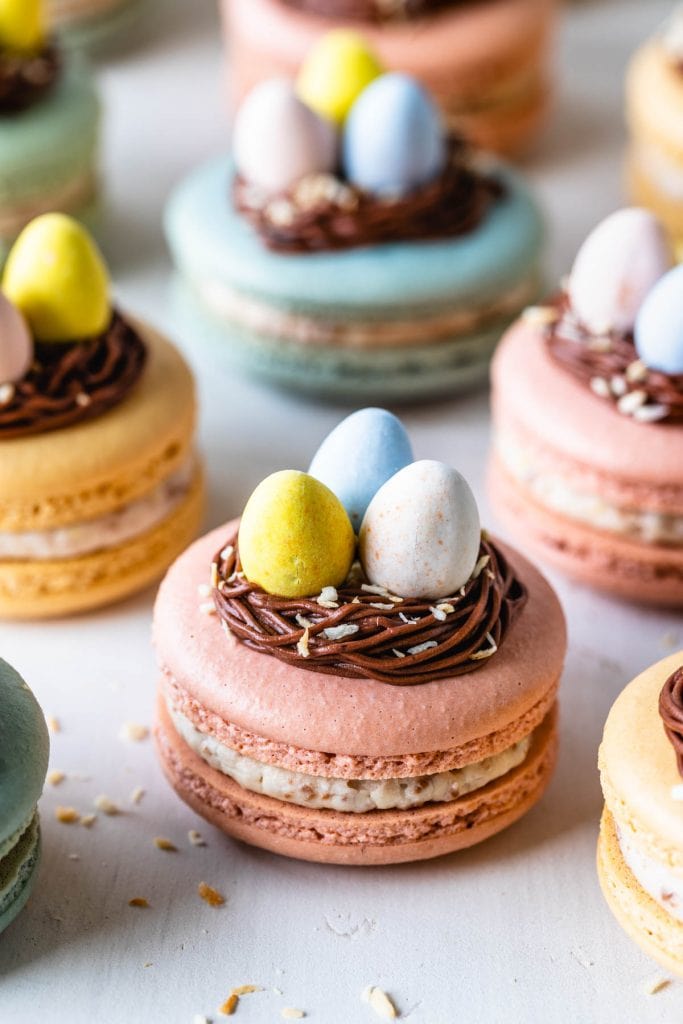
Large Circle Template
I piped these Nest Macarons larger so I could be able to make a large nest on top.
The circles have a 2.3″ diameter.
Here is the template if you want it. Download it, print it, and place under your mat or parchment paper to pipe the larger circles.
Have in mind that larger shells take longer to dry and may take longer to bake.
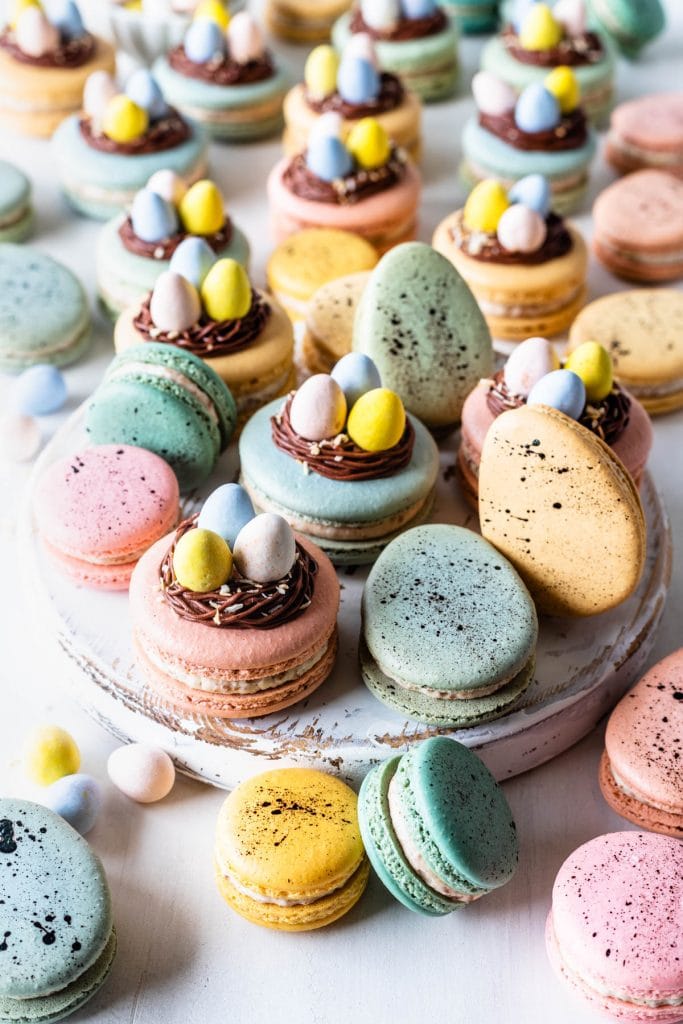
Here are some more Easter Macarons, and other macarons perfect for Spring and for this time of the year that you may like:
- Bunny Macarons
- Carrot Cake Macarons
- Robin’s Eggs Macarons
- Lemon Macarons
- Coconut Macarons
- French Vanilla Macarons
- Vanilla Bean Macarons
- Spring Macarons
- Earl Grey Macarons
- Chai Macarons
- Oreo Macarons
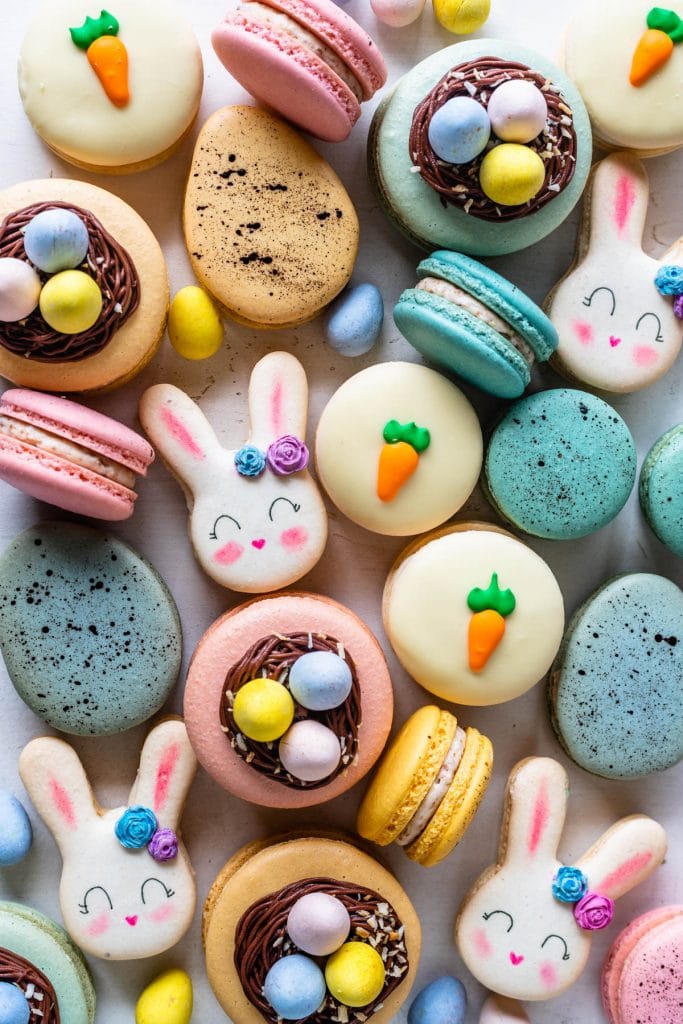
I hope you enjoyed today’s recipe! If you make this recipe please leave a comment below or tag me on instagram so I can see your work, I really love it when you share with me!
Thanks for reading!
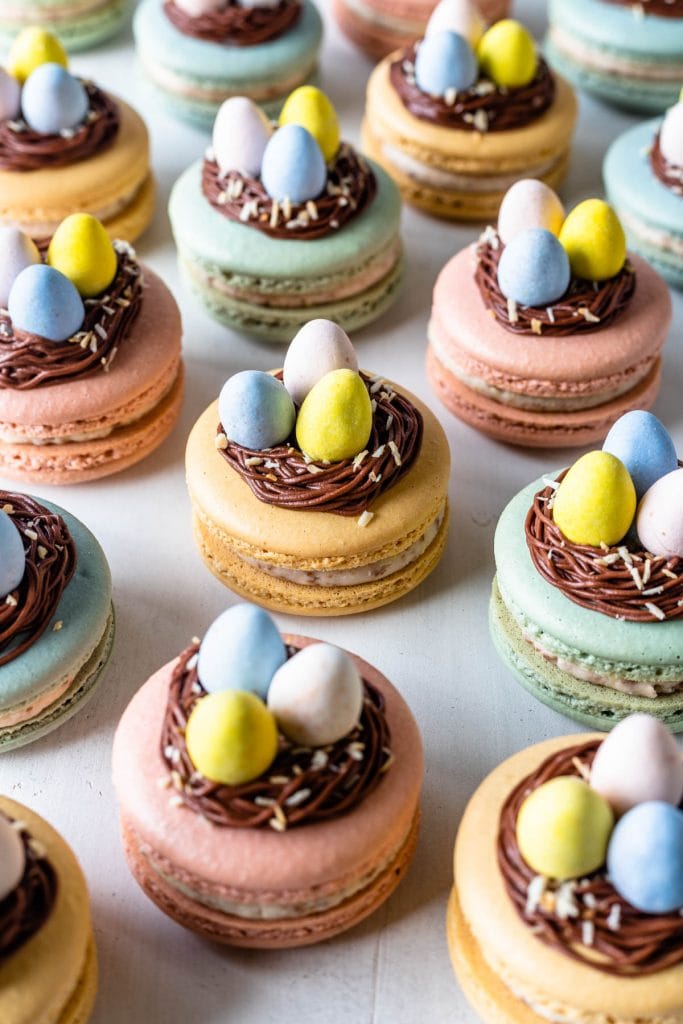
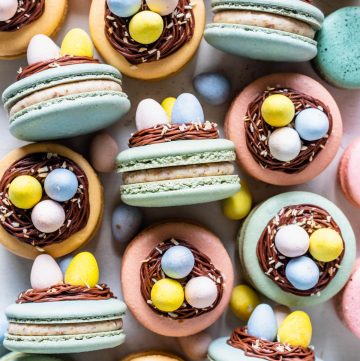
Nest Macarons
Ingredients
Macaron Shells
- 100 grams granulated sugar
- 1 gram egg white powder *read note
- 50 grams carton egg whites *read note
- 50 grams fresh egg whites *read note
- 105 grams almond flour
- 105 grams powdered sugar
- Food coloring I used Wedgewood, Yellow, and Pink.
Cadbury Egg Buttercream
- 4 tbsp unsalted butter room temperature 56 grams
- 1 1/2 cups powdered sugar 191 grams
- 1/3 cup powdered Cadbury mini eggs from about 2/3 cup whole candies
- 1/2 tsp vanilla extract
- 2-4 tbsp milk
Chocolate Frosting (for the nest)
- 4 tbsp unsalted butter 56 grams
- 1/4 cup cocoa powder 30 grams
- 1 1/2 cup powdered sugar 191 grams
- 2-4 tbsp milk
- 1/2 tsp vanilla extract
To decorate
- Mini Cadbury Eggs
Instructions
Macaron Shells
- Before you start, get all of the ingredients ready. Prepare a large piping bag, fitted with a large round tip, I use a 1/2” diameter tip. Set aside.
- Line two baking sheets with parchment paper or silicone mat.
- Measure out all of the ingredients.
- Sift the powdered sugar and almond flour together. Set it aside.
- Place a bowl over a pan with barely simmering water, add the sugar and the egg white powder, if using, to the bowl. Then add both the fresh and the carton egg whites to the bowl. Reminding you to read the notes below, but basically you don’t need to add egg white powder, it is completely optional, and also, you can use 100% carton egg whites or 100% fresh whites if you don’t want to to half of each.
- The reason why I chose to use egg white powder in today’s recipe is also to make the meringue a bit stronger, since the carton egg whites often times produce a slightly soft meringue.
- Whisk the mixture until frothy and the sugar is completely melted. It will take a couple of minutes. You can test by touching the mixture between your fingers, and if you feel any sugar granules just keep whisking the mixture over the water bath.
- Make sure the bottom of the bowl isn’t touching the simmering water because you don’t want the whites to cook.
- Also, don’t overheat the sugar syrup, this may cause issues down the line, such as wrinkly macarons.
- Transfer the syrup to the bowl of a stand mixer.
- With the whisk attachment, start whisking mixture on low for about 30 seconds, then gradually start increasing speed to medium. Whisk on medium for one to two minutes, until the mixture is white and starting to become fluffy. Raise the speed to medium-high and whisk for a few minutes until stiff peaks are formed. Best way to check this is to keep your eye on the whites. Once they get glossy and you start seeing streaks formed by the whisk, it might be time to stop.
- Whisk until stiff peaks have formed. When you pull your whip up, the peak should be stiff and shooting straight up, with possibly a slight bend at the top, but not bending down to the side.
- With the carton egg whites might take a bit longer than using 100% fresh egg whites to achieve the stiff peaks. And even when stiff peaks form, they might look a bit softer than they would if made with fresh whites. Adding the egg white powder and a bit of fresh whites can help with this though.
- Pour the sifted powdered sugar and almond flour into the stiff meringue.
- I made the batter into 3 different colors to make it fun. You can just make one color if you want to, but here are the instructions to make the multicolor shells from the same batch.
- Start folding gently forming a letter J with a spatula.
- As soon as you see no more dry ingredients in the meringue, stop stirring. Divide the batter between three different bowls (or however many bowls as you’d like).
- Work with one bowl at a time, leaving the other ones covered meanwhile.
- To the first batter I added a touch of wedgewood food coloring by americolor. You can also obtain this color adding a bit of royal blue food coloring and a touch of purple. Fold the batter until the perfect consistency is achieved.
- How to know when to stop folding the batter: It’s time to stop folding when the batter is glossy and has a thick and flowing consistency. There are several ways to test this.
- First, pick up some batter with the spatula and try to draw a figure 8 with the batter that is dripping off the spatula. If you can form several 8 figures without the batter breaking up, that’s one indication that it might be ready.
- There’s another test you can do. I call it the Teaspoon test.
- Grab a teaspoon of batter and spoon onto the parchment paper or silicon mat. Wait a minute to see how it behaves.
- If the batter stays stiff, forming a point and doesn’t spread out, fold a little bit more, about 3 folds. Test again.
- Once the batter spreads out a bit and starts to look glossy and smooth on top, on the parchment paper or silicone mat, it’s ready.
- You don’t want your batter to be too runny either. So be careful not to over mix. It’s always best to under mix and test several times until the proper consistency has been achieved.
- When you hold the spatula with batter on top of the bowl and the batter falls off the spatula slowly but effortlessly the batter is ready. The batter will keep flowing off the spatula non-stop, but not too quickly.
- Transfer the batter to the piping bag. Seal the top with a bag tie so the batter doesn’t dry out.
- I did notice that the macarons made with carton egg whites require way less macaronage time, so this is something to have in mind because you don’t want the batter to be over mixed.
- Now, it’s time to work with the second batter. To this batter I added a bit of yellow food coloring, then fold until the perfect consistency is achieved, like I’ve explained above.
- Transfer the batter to another piping bag fitted with a round tip. Secure the top with a bag tie. Set aside.
- Now time to work with the final batter, I added a little bit of pink food coloring. Fold and then transfer the batter to a piping bag fitted with a round tip and secure the top with a bag tie.
- Place the piping bag directly 90 degrees over the center of each macaron template. Apply gentle pressure and carefully pipe for about 3 to 5 seconds, and then quickly pull the bag up twisting slightly. I made larger macarons to make the nests on top, I am providing a template for the larger circles on the blog, you can print them and place under your mat to pipe the shells. The circles measured 2.3”.
- Once you’ve piped as many circles as you could, bang the trays against the counter a few times each.
- Use a toothpick to pop any air bubbles in the surface of the shells.
- Let the trays sit for a while so the shells will dry out a little bit. I usually leave about 20-40 minutes, depending on how humid the day is. Larger shells may take a bit longer to dry. You’ll know they’re ready when you gently touch the surface of a macaron and it seems dry.
- Pre-heat the oven to 300ºF.
- Bake one tray at a time.
- Bake for 5 minutes, rotate tray.
- I bake each tray for about 15 to 20 minutes.
- When baked, the macarons will have a deeper color and formed feet. If you try to move a macaron, it shouldn’t feel jiggly. If the macaron is still jiggly, keep baking.
- Remove from the oven and bake the other tray.
- Let the macarons cool down before proceeding with the filling.
- You can also place a piece of foil or parchment paper halfway through baking to prevent the macarons from browning too much for the pastel colors.
Cadbury Egg Buttercream
- Put the Cadbury eggs in a small food processor and process until finely ground.
- Beat the butter with an electric mixer for 1 minute. Add the powdered sugar and powdered Cadbury eggs. Mix on low until ingredients are combined. Raise speed to medium high and beat for one minute.
- Add the milk if necessary and also the vanilla.
- Mix to combine.
- Add more milk if frosting seems too stiff, about 1/2 teaspoon at a time. And add some more sifted powdered sugar if the frosting needs to be thicker.
- Transfer the frosting to a piping bag fitted with a round tip.
Chocolate Frosting (for the nest)
- Start by sifting the powdered sugar, and cocoa powder in a small bowl. Set aside.
- Add softened butter to the mixer bowl, and beat on medium-high speed for 1 minute.
- With the mixer off, add powdered sugar, cocoa powder, and milk.
- Mix on low until dry ingredients are incorporated with the butter.
- Raise the speed to medium-high, and cream from 30 -60 seconds, until smooth.
- Add the vanilla and mix.
- The frosting should be smooth, thick, not too stiff. Add more milk if the frosting is too stiff, and add more powdered sugar if the frosting is too runny and you went overboard with the milk.
- Always remember the a little bit of liquid here goes a long way, so you don’t want to be adding too much milk to the frosting. Transfer the chocolate frosting to a piping bag fitted with a small grass tip.
To assemble
- Pipe a bit of the Cadbury Egg Buttercream in the center of each macaron.
- Top with another shell.
- On the top shell, pipe a tall ring of the chocolate frosting using the grass tip to form a nest.
- Sprinkle some toasted coconut on top if desired to create a bit of texture.
- Place a few Cadbury mini eggs in the middle of the nest.
- Let the macarons mature in the fridge overnight before serving.
Storage
- Store the macarons in the fridge for up to 5 days or in the freezer for up to 1 month.



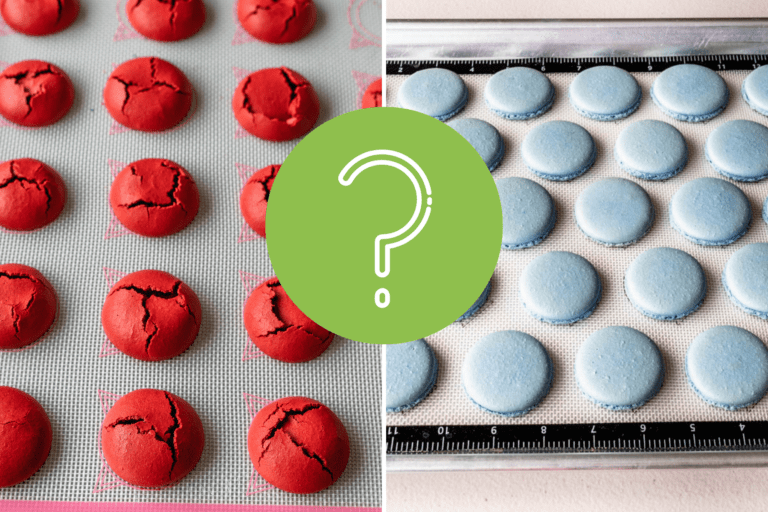
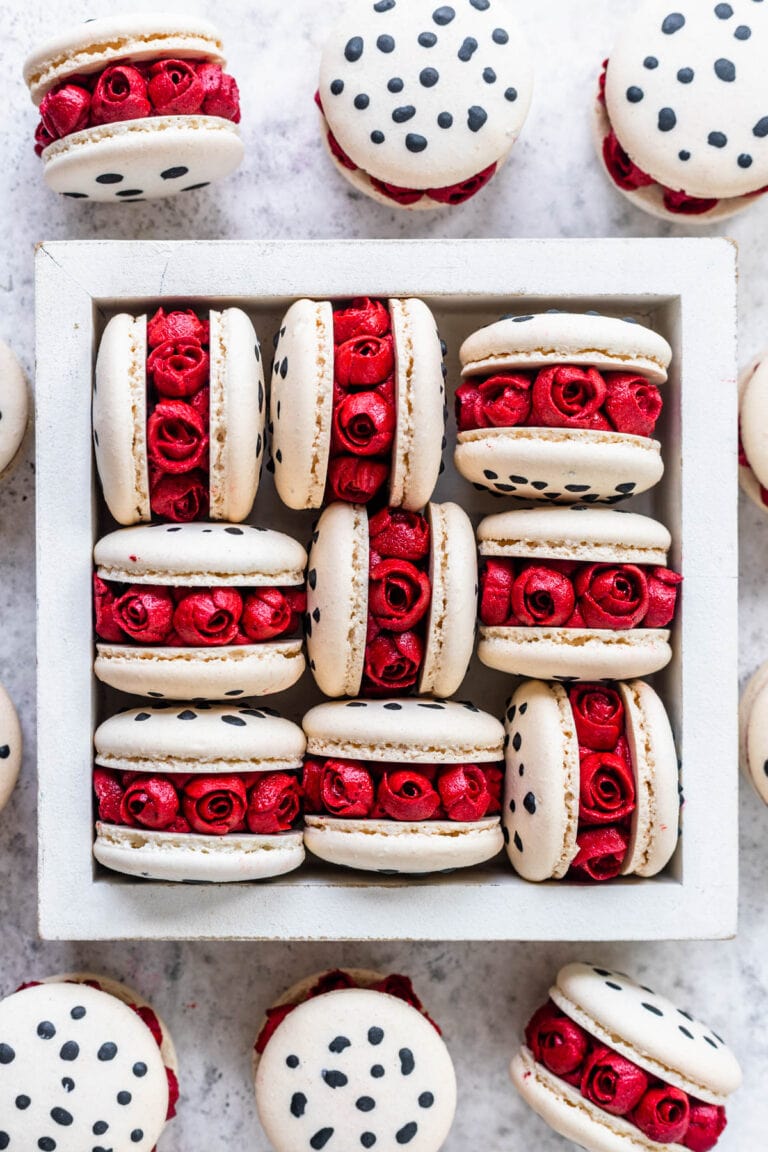
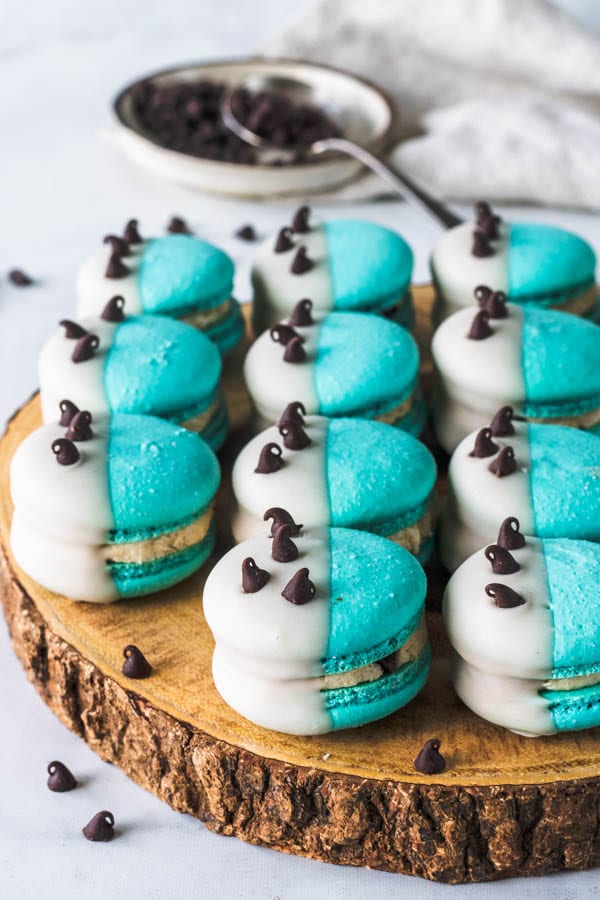
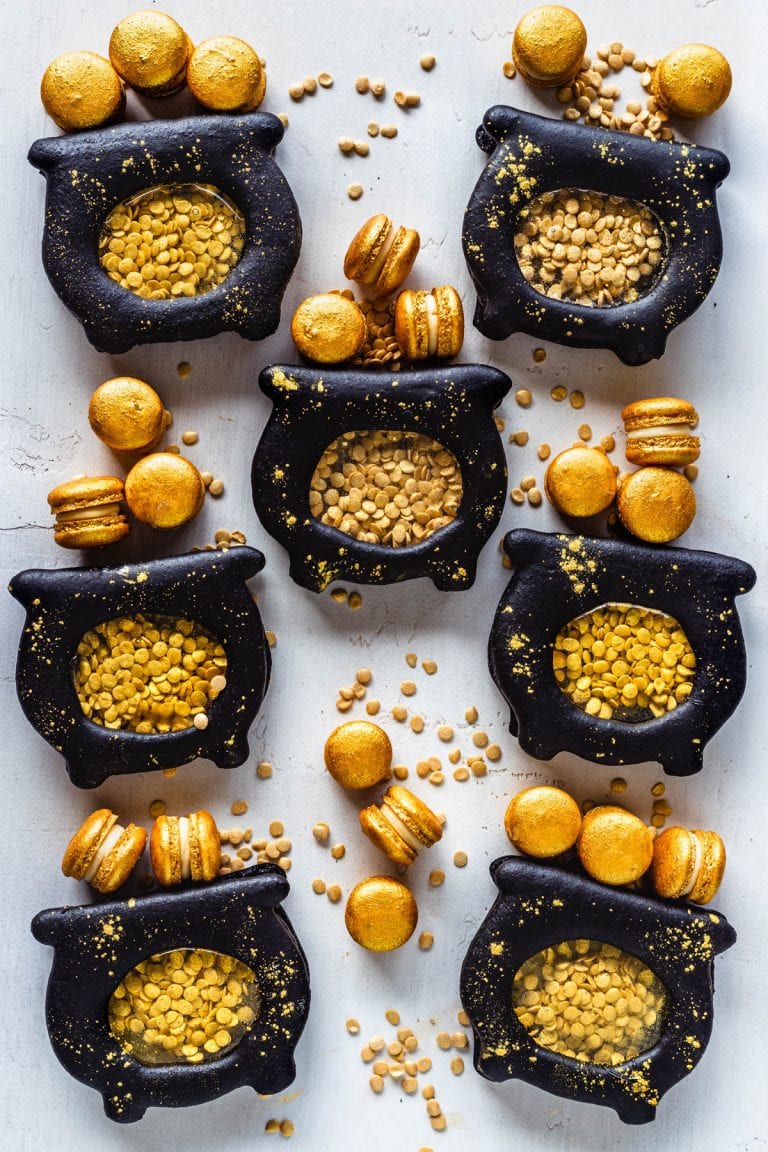
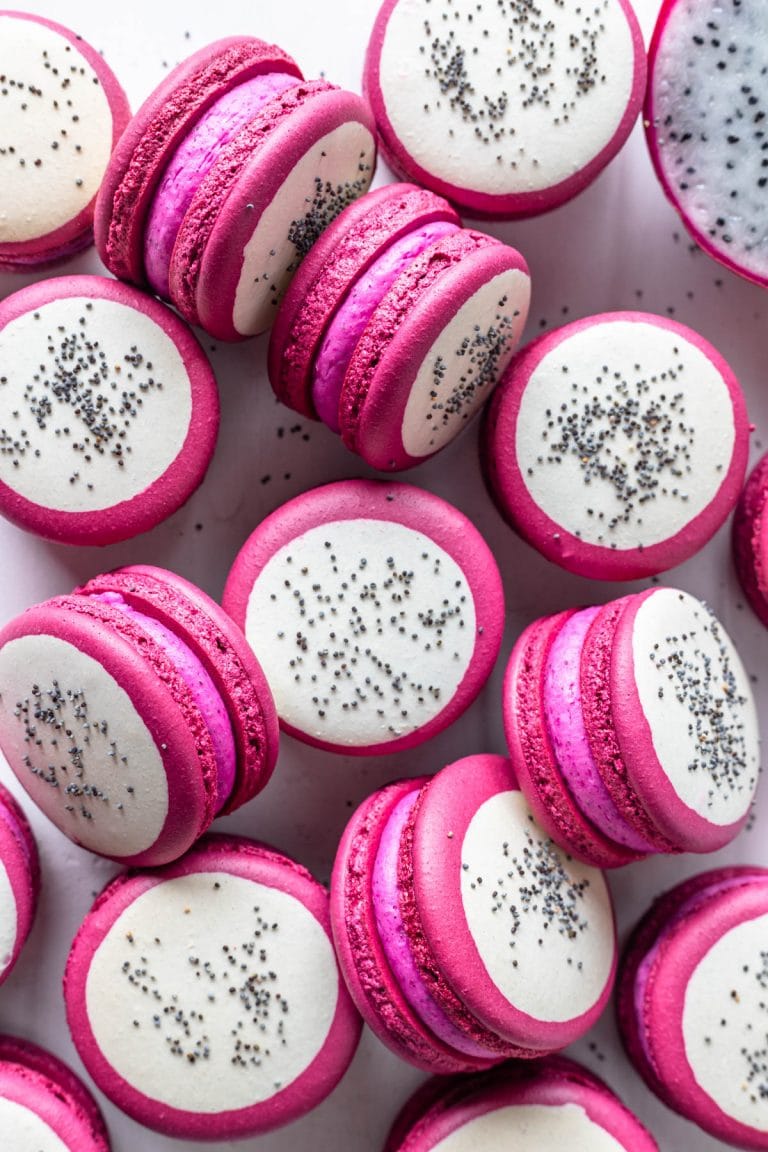
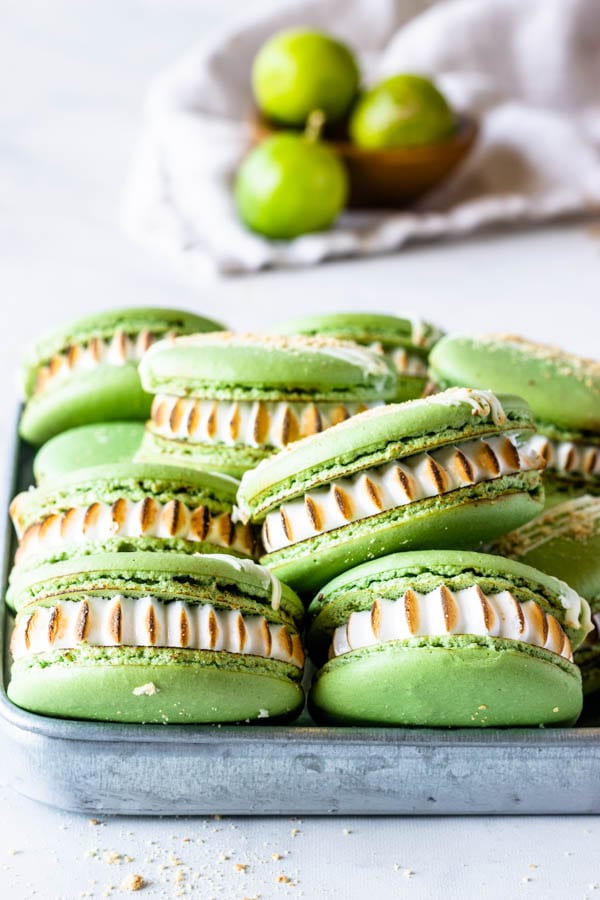
Sensacionais, muito criativo!!!!!!!
Que lindeza!! Feliz Páscoa, Camilinha!!🥰😍🐰
Que lindeza!! Adorei a receita! Deliciosa!!